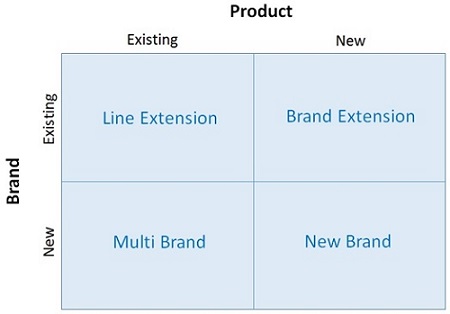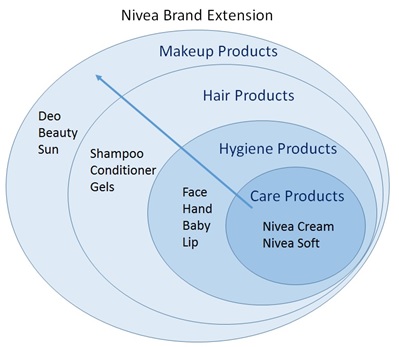
- Inside Brand Management
- Brand Management - Equity
- Brand Management - Equity Models
- Brand Management - Architecture
- Brand Identity and Positioning
- Brand Management - Promotion
- Brand Management - Extension
- Brand Management - Co-branding
- Maintaining The Brand
- Brand Management - Performance
- Brand Management - Leveraging
- Brand Management - Valuation
- Brand Management Resources
- Brand Management - Quick Guide
- Brand Management - Useful Resources
- Brand Management - Discussion
Brand Management - Extension
Brand extension is required for a companys growth, profitability, and brands added reputation. It is an inevitable strategic move at some point of time in brand management.
While extending a brand, all assumptions related to that brand held for a long time are revised and the brands identity is redefined. The brand managers need to identify growth opportunities and increase parent brands value.
What is Brand Extension?
It is nothing but launching a product in a different category under an already established brand name. It is extending the existing brand promise with diverse products or services.
The following diagram shows the matrix of brand growth.

When a company introduces a new product, it has the following choices −
New Brand, New Product (New Brand)
New Brand, Existing Product (Multi-Brand)
Existing Brand, New Product (Brand Extension)
Existing Brand, Existing Product (Line Extension)
The last two in the above list are the types of brand extensions.
Line Extension
A variation of existing product launched under the existing brand. It often adds different flavor, package size or shape. Here, established brand is the parent brand.
For example, Coke is basic brand with Diet Coke as extension.
Brand Extension
A new product is launched under existing brand. It often adds a product of different category. The new associated brand is a sub-brand.
For example, ITC brand with Sunfeast cookies, Vivel shampoo, Bingo chips as its sub-brands. In 1994, Titan Industries Ltd. extended the brand Tanishq, Indias only national jewelry brand.
Let us see yet another excellent example of systematic brand extension, Nivea.

Risks of Brand Extension
Just like product launching, brand extension demands time, resource allocation, energy, and associated risks. When the brand is exposed into unknown market, it might face dominance among established competitors. In addition, the brand image can come into trouble too.
Pros of Brand Extension
- Bypass efforts, time, and cost for developing a new brand.
- Leverages the reputation attached to the parent/family brand.
- Saves costs on follow-ups and introductory marketing programs.
- Reduces perceived risk of customer about the product.
- Elevates the parent brand image.
Cons of Brand Extension
- On failure, brand extension can hurt the parent brand image.
- It can cannibalize parent brand if the sub-brand is more successful than parent brand.
- Creates confusion among customers if not communicated appropriately.
- Can dilute brand meaning.
Brand Adaption Process
Brand adaption is nothing but introducing and engaging the consumer with the brand. It involves five steps −
Awareness − Customer knows the brand but does not have complete information.
Interest − Customer tries to find more information on the brand.
Evaluation − Customer tries to know how beneficial the brand would be.
Trial − Makes first purchase to determine its usefulness or worth.
Adapt/Reject − Becomes a loyal customer or looks for some other parallel brand.
Brand Adaption Practices
The brand adaption practices involves the following steps −
Develop internal (brand managers and representatives) and external launching (consumer and prospects) of brand.
Impart positive attitude towards the brand among sales managers and marketers.
Create high customer demands and expectations about the brand.
Provide training for the sales and customer care force to practically deliver the brand promise.
Factors that Influence Brand Extension
There are various scenarios where a brand has successfully extended or failed to extend. For example, Bic ballpoint pens. It extended successfully into disposable razors but the extension into perfumes was a failure.
The factors that influence acceptability of a brand extension are mainly −
Perceived risk − It is the evaluation of uncertainty about the type and degree of expected loss after making the consumer makes a choice.
Consumers Innovativeness − Personal trait or desire of consumers to try a new brand/product and thereby experience something new.
Product Similarity − Greater the degree of similarity of the extended product with the original product, more is the chance of transferring the positive effect.
Parent Brand Reputation and Strength − Brands reputation is associated with the consumers perception of the quality of the brand. Strong and reputed brands leverage extension than weak brands.
Rebranding
A company requires to rebrand when it decides to change any of its brand elements such as brand name, logo, slogan, or even a small change in the message for better communication and more relevant brand promise. Rebranding is extremely important, expensive to execute, and risky.
Why do Companies Rebrand?
There are multiple reasons behind why companies initiate rebranding. These reasons can be categorized into two types − proactive or reactive. Let us take a deeper look.
Proactive Rebranding
It happens when a company anticipates and prepares for future changes in the market.
To prevent or prepare for future potential threats by competitors.
To plan for international growth, rebranding the products and services into a consolidated brand thereby saving money over time and creating a greater sense of brand unity.
To enter into a category of business, product, or market which no longer remains cohesive to the existing brand identity. In case of Apple Inc., as the company evolved into new businesses beyond computers, the original brand name Apple Computers became too restrictive. It was then changed to Apple Inc. At the same time, Apple Inc. updated its logo depicting its progress.
To attract new audience, or want to appeal to it. In case of McDonalds ads, it refers to itself as McDonalds to target a different demographic from its traditional audience.
To increase the brand relevance in consumers mind, the company might decide to rebrand. For example, when the use of printed Yellow Pages directories started declining, Yellow Pages rebranded to YP.
Reactive Rebranding
This branding occurs when the companies need to react to a significant change. Reactive rebranding might happen in the following situations −
-
When companies need to work on negative brand image.
For example, during 1990-2000, the London based mens clothes making company Burberrys public image was associated with hooliganism and violence. The brand had lost its image so badly that the clubs and pubs in UK had started banning entry for the people wearing Burberry. The company worked to disassociate itself from such an image by changing styles of the product, changing their logo, and applying excellence in everything.
When companies merge or acquire other companies, or when they separate. For example, California based Intel rival and chipmaker, Advanced Micro Devices (AMD) is considering to split shortly.
When there are legal issues with branding. Trademarks are often the root cause for rebranding. For example, an Australian business tries to expand into USA and finds that its existing name is already trademarked and not available for use in USA.
When a competitor manifests a companys brand as useless or outdated, then rebranding helps to get an opportunity to facelift the brand to effectively strike back in the market.
When changes take place in business regulations, laws, competitors, etc.
When a company lands up into a significant controversy or negative publicity, it considers rebranding to rebuild the trust of consumers and stakeholders. It cuts up all the ties with the issues in picture and moves on with the new form of brand.
Relaunching
Relaunching a brand is reintroducing a brand into the market. Relaunching implies that a company was marketing the brand but stopped doing so for some reasons. Relaunching is an opportunity to set new objectives for the brand.
Relaunching a brand can demand the changes ranging from the aspects as minor as logo prints on stationery and cutlery, staff uniforms, to as major as website of the company, changes in premises, etc.
How to Relaunch a Brand?
When a company relaunches a brand, it hopes to avoid the mistakes from past experience and wants to set a strong foot in the market. A brand manager needs to consider the following dos and donts while relaunching a brand −
Analyzing the marketplace and target market segment.
Knowing about the competitor brands.
Conducting SWOT (Strengths, Weaknesses, Opportunities, and Threats) analysis.
Positioning the brand in an appropriate new form.
Avoiding too many changes in too short time. This type of strategy can lead to the risk of not retaining consumers attention and interest for a long time. In future, it can make the company and its products unrecognizable to its existing customers. Let the consumer know about the new form the brand has taken.
Communicating clearly about the brand relaunch. Creating awareness among people about new objectives and distinctive offers. Making the changes gradually and noticeably.
Let us see an example of NIVEA FOR MEN relaunch. In 1980, NIVEA introduced an alcohol-free, non-itching aftershave balm for men. It went popular with consumers, and then by 1993, NIVEA FOR MEN included a range of skincare products for men.
By 2008, more and more men were investing in skincare and grooming products. NIVEA FOR MEN brand understood this as an opportunity to claim more market share in the growing category. To achieve this, NIVEA employed a strategic marketing to relaunch and reorganize.
NIVEA assessed the marketplace, evaluated its own business, brands, and products. It also assessed the brands position and the state of the market. It conducted SWOT analysis and revealed some interesting facts such as women are an important target market for the brand NIVEA FOR MEN as they are instrumental in buying male grooming products for their partners as well as helping them to choose new ones.

Well-informed with SWOT analysis data, NIVEA FOR MEN brand management set objectives for relaunch. Using research data to forecast trends, the marketing force set SMART (Specific, Measurable, Achievable, Realistic) objectives. This helped in increasing sales, growing market share, and improving its brand image.
NIVEA FOR MEN adopted a range of key performance indicators to assess the success of the NIVEA FOR MEN relaunch in the UK. It revealed that −
NIVEA FOR MEN is the market leader in many countries and is consistently gaining additional market share.
Internationally, NIVEA FOR MEN skincare products sale increased by almost 20 percent.
The NIVEA FOR MEN brand image improved in the minds of consumers.
NIVEA FOR MEN entertained its customers feedback and added products to its line and reformed the existing products.